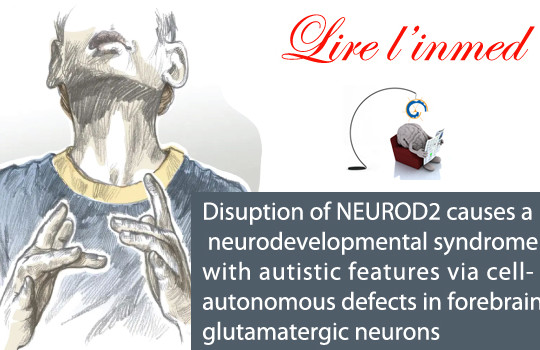Authors: Runge, Mathieu, Bugeon, Lafi, Beurrier, Sahu, Schaller, Loubat, Leonard Herault, Gaillard, Pallesi-Pocachard, Montheil, Bosio, Rosenfeld, Hudson, Lindstrom, Mercimek-Andrews, Jeffries, van Haeringen, Vanakker, Van Hecke, Amrom, Küry, Ratner, Jethva, Gamble, Jacq, Fasano, Santpere, Lorente-Galdos, Sestan, Gelot, Giacuzz, Goebbels, Represa, Cardoso, Cremer & de Chevigny
Brain development at the cross-road. Expectations are high that research elucidates the neural basis of two major neuro-developmental disorders, autism and epilepsy. Here the authors found that NEUROD2, whose mutation was previously linked to epilepsy, is a key actor of cortical networks development and that its defection is a determinant of autism. Indeed, its absence in the mouse cortex causes defects in lamination, dendritic spine growth, neuron electrical properties, and at the behavioral level, an autistic-like phenotype in social interactions and stereotypies. Finally, gene mutations were found in families with ASD, and these same mutations introduced in cultured cells or in the mouse brain were pathogenic. Hence, NEUROD2 seems to put brain development on the right track. (by Ingrid B.)
Scientific abstract: While the transcription factor NEUROD2 has recently been associated with epilepsy, its precise role during nervous system development remains unclear. Using a multi-scale approach, we set out to understand how Neurod2 deletion affects the development of the cerebral cortex in mice. In Neurod2 KO embryos, cortical projection neurons over-migrated, thereby altering the final size and position of layers. In juvenile and adults, spine density and turnover were dysregulated in apical but not basal compartments in layer 5 neurons. Patch-clamp recordings in layer 5 neurons of juvenile mice revealed increased intrinsic excitability. Bulk RNA sequencing showed dysregulated expression of many genes associated with neuronal excitability and synaptic function, whose human orthologs were strongly associated with autism spectrum disorders (ASD). At the behavior level, Neurod2 KO mice displayed social interaction deficits, stereotypies, hyperactivity, and occasionally spontaneous seizures. Mice heterozygous for Neurod2 had similar defects, indicating that Neurod2 is haploinsufficient. Finally, specific deletion of Neurod2 in forebrain excitatory neurons recapitulated cellular and behavioral phenotypes found in constitutive KO mice, revealing the region specific contribution of dysfunctional Neurod2 in symptoms. Informed by these neurobehavioral features in mouse mutants, we identified eleven patients from eight families with a neurodevelopmental disorder including intellectual disability and ASD associated with NEUROD2 pathogenic mutations. Our findings demonstrate crucial roles for Neurod2 in neocortical development, whose alterations can cause neurodevelopmental disorders including intellectual disability and ASD.
Published in Molecular Psychiatry in June 2021

